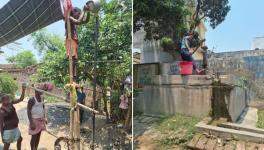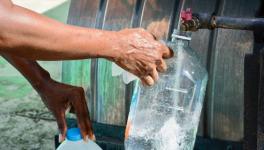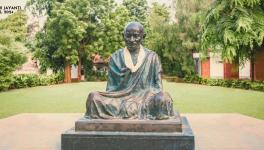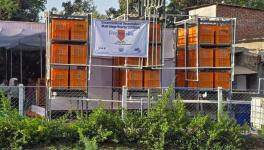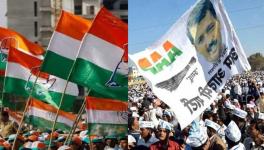How Gujarat Government is Deepening the Water Crisis
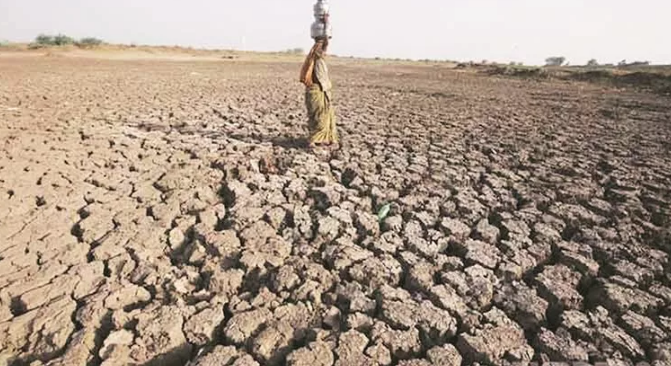
Image Courtesy: The Indian Express
Gujarat, the state synonymous with a ‘developmental model’, is facing the worst water crisis in its history. With 5% population of the country, Gujarat has accessibility to just 2% of the country’s water resources. While the state is unable to draw ground water because of the rocky profile of a widespread terrain, the variation in rainfall adds to the woes of the populace. The state government has certainly taken steps in order to resolve the issue but the scope of the steps have been largely unproductive and controversial. At large, the root causes behind the impending crisis are–legislative miscalculation, water mismanagement and social discrimination.
Legislative Miscalculation
The recent addition to the irresponsible legislation in the state is the Gujarat Domestic Water Supply (Protection) Bill, 2019, and the Gujarat Irrigation and Drainage (Amendment) Bill, 2019, which may drive the citizens, if implemented, with furore.
The bills were passed, on July 26, in spite of strong opposition from Congress legislators who referred the bills as anti-farmer and ‘black law’. Saurabh Patel, the energy minister, however, maintained that the bills would “stop the menace of water theft”. Moreover, the provision of fines and punishments in the bills are draconian and aim at benefitting industries. Fines range from Rs 1,000 to Rs 2,00,000 and punishment includes a maximum of two years of imprisonment. Any person carrying the cattle to the canal will now be imprisoned for three months or a fine of Rs 10,000 will be slapped.
The government justified the fines extended to farmers with the aim of transparency and neutrality. In contrast, both the uncorroborated bills have zero provision for strict penalty on industrial units polluting water bodies on regular basis. A NewsClick report showed how “Deepak Nitrite, a Vadodara based chemical factory was releasing hazardous waste into water bodies like Sabarmati river under Gujarat government’s nose.” And yet, Gujarat government is yet to take action against this serial violator. This is just a small illustration of a colossal crisis the state government is imposing on its people with sheer absence of vision to comprehensibly address the looming issue.
Also read: #DroughtDistress: Farmers, Pastoral Communities Suffer in Gujarat
These newly introduced bills may be called ‘legitimate’ successors of Gujarat Act No. 18 of 1979. The 1979 Act certainly empowered the Gujarat Water Supply and Sewage Board to operate, maintain, augment or improve the water supply system but the act failed to go into the details of how assessment of execution of the board will function. The act further made the local water bodies a business-oriented machinery by empowering it to enter into contracts. The act had the provision for auditor but it did not comment on its independent authority. The auditor continues to be appointed by the government with no consent of opposition party or any authority independent of government, thereby making the chair subservient to the regime. The act was amended in 2011 only to induce an engineer or bureaucrat as the member-secretary of the board by altering section 4 of the act. The amendment also does not describe in detail what task the engineer would serve. Second, the amendment seeks an opportunity to fill the engineer’s place with a bureaucrat, whoever the government feels is suitable for the post, enriching the aimlessness of the amendment.
The accountability of such government bodies is critically missing, thus, ossifying the purpose the board was once levelled for. The problem exists in legislation which is rarely supported by empirical studies but solely relies on the draped ideas of ‘all rounder’ bureaucrats, whose hectoring tone many times diminish the possibility for the government to entertain a second opinion on the subject of legislation. The question of intake of technical suggestions of experts critical of the government’s programmes and projects also does not come into play, which fails the purpose of democracy too. To realise the potential of legislation, the government has to reduce bureaucratic highhandedness and approach the experts in the field of hydrogeology, water management, and sociology to logically address the situation.
Water Mismanagement
The state government has shown some willingness to address the issue in the form of a document called Vision 2020 but, again, the plan overawes theoretical binding and overlooks the reality. Key projects in the water sector are organised under three categories, i) Industrial and drinking water supply projects ii) Kalpasar project, and iii) Irrigation sector projects.
However, the report of Comptroller and Auditor General (CAG) audit on National Rural Drinking Water Programme of 2018 unfolds the truth behind the Gujarat government’s efforts on the first above-mentioned category of drinking water supply. The audit, covering Banaskantha, Bhavnagar, Junagadh, Mehsana, Narmada, Navsari, Panchmahal, Surat, Surendranagar and Vadodara districts, “collected water sample test results (2012-17) of 73 habitations from 20 Talukas from water testing District and Taluka laboratories and found that 146 out of 700 samples taken were contaminated due to presence of excess fluoride and nitrates.” The report further notes that any remedial action was not taken following test results. In fact, the audit observes that 142 villages out of 945 covered villages in seven districts, for a time period between 2012 and 2017, were not getting water due to technical problems such as low water pressure at tail end villages, non-availability of necessary infrastructure and lack of internal pipeline network in the village. In three out of the ten selected districts, 17,47,075 thousand litres of water was supplied through tankers to 4 to 193 villages during 2012-13 to 2016 17, due to non-availability/insufficient availability of potable water. State records accessed by CAG, by contrast, say that all the habitations were fully covered. A total of 10,913 samples (14%), out of 77,064 samples tested in water testing laboratories during 2015-17 were found unfit for drinking due to presence of fluoride, nitrate, alkalinity, hardness, etc.
CAG further rubbishes the Gujarat government’s flagship scheme of Narmada, No-Source Regional Water Supply. CAG finds that in Narmada district, where Part-II of the scheme was executed with the aim to provide potable water (surface water) to habitants of 12 fluoride affected villages, the pipe line failed (November 2013 to August 2014) in hydro testing due to leakages at various locations. The project incurred an expenditure of Rs. 3.73 crore out of the granted Rs. 4.70 crore and work remained incomplete as the contractor went for arbitration.
Also read: No Water But Gutter and Garbage: Vadodara’s Minorities Living in Hell
The Vision 2020 document, prepared in 2015, boasted that the Kalpasar project would be fully completed by 2018-19 but that was just to inveigle the voters. Its fate remains unclear to this date. In truth, the Coastal Vulnerability Index (CVI), which measures the anticipated sea-level rise, showed that 45.67% of the Gujarat coast falls under high to very high risk category, which means that the Kalpasar project, on a part of the endangered Gulf of Khambhat is scientifically infeasible. An amount Rs. 30.71 crore, according to a report, has already been spent on project, government says, to benefit the Saurashtra region. The justification by the government, intromitten in this context, is misleading as people in Saurashtra are those of the worst affected. Canals in the summer run dry and farmers are not supplied with water meant for irrigation.
The Vision 2020 document looks forward to collocate some more irrigation projects but the projects that the government has claimed to have implemented are already in tatters. Sujalam Sufalam Yojana, meant for enhancing lift irrigation, has completely failed in North Gujarat region. Farmers in Aravalli district were left to beg this year as there was no water in Narmada river’s Sujalam Sufalam canal to irrigate the fields. The condition in South Gujarat was no different at the time, Ukai canal running across Surat, Tapi, Narmada and Bharuch dried up, successively resulting in the failure of Rabi crop.
The government has failed to pay attention to rainwater harvesting which could help the administration to deal with water shortage. Construction of rain water harvesting system in government buildings was planned under Narmada and Water Resources, Water Supply and Kalpsar Department, and it was made mandatory for all the government buildings to have rainwater harvesting system. But available data affirms that only 6% of the terrace area was brought under rainwater harvesting system till 2013, and even though the department’s website is regularly updated, the data after financial year 2012-2013 is not available on the website. Government released a handbook on water harvesting and groundwater recharge in May 2014, but the condition remains grim due to lack of awareness.
Social Discrimination
The caste system and religious marginalisation find rigid presence in Gujarat, and these social ills now have now found acquiescence in the parched fields as the water crisis looms large. A NewsClick report shows “how the water supply to a Vadodara slum occupied by Muslims and Marathas was blocked” but the bordering posh residential societies had more than adequate access to the water. From another report, one can learn about the difficulties of “semi-nomadic cattle herders who migrated last year from Kutch to Sanand to survive as canal, the only water source, dried up in the arid region killing a number of buffaloes owned by the herders.” Several industries set up in Gujarat continue to receive unhindered access to water throughout the year, but farmers are forcefully displaced internally. It is not difficult to conclude that these scaring inequalities are strictly manufactured by the government machinery, albeit at a lower hierarchical level.
Among several factors contributing to the water crisis, social discrimination is one of the root causes. While the natural order vis-à-vis climate change, imbuing drought or flood, is difficult to control, social discrimination can easily be obviated. However, caste violence is on rise in the state and soon it may also develop a grip on water crisis. The days are not far when access to water will be controlled by dominant strata and the marginalised in the ghettos will be left to suffer.
Also watch: Saurashtra and Kutch: Elections Under the Shadow of Drought
The political party, incumbent in Gujarat, which feeds on the political platter of ‘Pakistan’ is ignoring the fact that its policies in the state is turning it into Pakistan where every drop of water counts. Pakistan’s government similarly ignored the water emergency; now, the country is set to be classified as water “scarce” and Gujarat too is moving parallelly towards the same. In fact, it is the people who are meeting the comeuppance of voting for a toothless government which believes that legislation will alone solve the problem.
Get the latest reports & analysis with people's perspective on Protests, movements & deep analytical videos, discussions of the current affairs in your Telegram app. Subscribe to NewsClick's Telegram channel & get Real-Time updates on stories, as they get published on our website.










